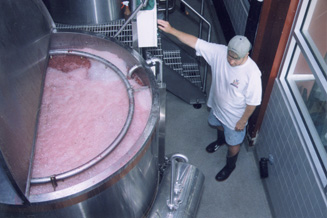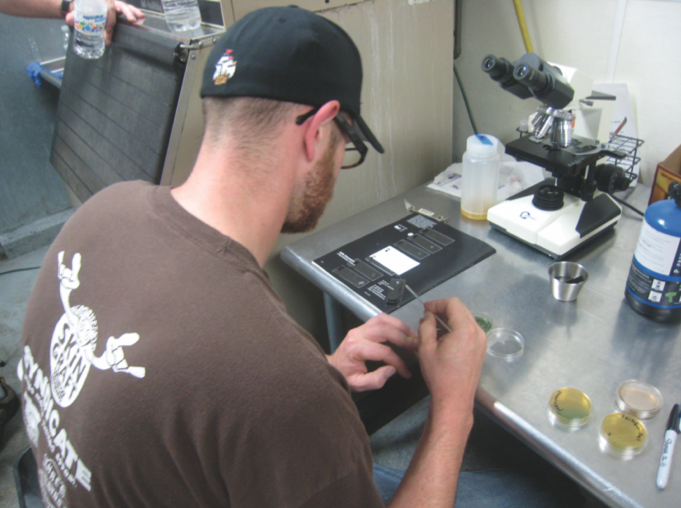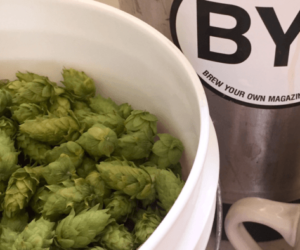A Taste of the Pro’s Life
—
Many a homebrewer has dreamed of making beer for a living. Wouldn’t it be awesome to spend your work days brewing? Could it be as cool as we imagine? What is the life of a craft brewer really like? To find out, Brew Your Own went behind the scenes at a 10-barrel brewery in Atlantic City, N.J., to get an insider’s look at the working world of brewmaster Mark Cohen.
Cohen runs the brew kettle at the Tun Tavern, a new, 270-seat brewpub in the Jersey shore’s gaming mecca. The Tun is inside the Sheraton Hotel, connected to the city’s new convention center.
Cohen started his career in the Philadelphia/West Jersey market. He’s been a bartender, cook, waiter, bar manager, and banquet manager. He became a brewer almost by accident while on a stint in Nevada working in the food industry.
He had taken a job as a cook at the Holy Cow brewpub in Las Vegas, planning to work there only until he found a management position. But Holy Cow’s managers had other plans for him. They saw his potential as a brewer. “I thought, ‘Sure, I can do that.’ When I interviewed for the job, they asked me one question: ‘If you were going to buy a six-pack of beer, what kind would you buy?’ I said ‘Anchor Steam.’ They said ‘Okay, you’re hired,’” he says.
Thus began Cohen’s adventure in brewing. At Holy Cow, he apprenticed under Dan Rogers and stayed five years as Rogers’ assistant. He left for the chance to be brewmaster at a start-up brewpub in Arizona, then moved back to his native New Jersey to open Tun Tavern.
On brewing day Cohen arrives around 8 a.m. and gets ready to mash. After making his morning rounds of equipment inspection, he starts the brew. Today’s is a pale ale. He turns a switch to fill the mash tun with hot water, mixing in a little cold to bring it to strike temperature — around 168° F, the usual for a single-infusion mash.
The grist box is filled with 650 pounds of milled pale, Munich, and caramel malts. Cohen filled it the previous night, hoisting 50-pound bags of malt into a hopper on the other side of the brewery. From the hopper an auger pipe carries the malt to the grist box, which is bolted to the ceiling above the mash tun.
When the water level is right, Cohen stands ready with his long-handled stainless steel mash paddle. He opens the hatch at the bottom of the grist box, and a cascade of malt begins pouring into the mash water. He stirs vigorously to keep it wet.
The grist box runs empty. Cohen deftly stirs the mash at lower depths while leaving a layer of dry malt floating on the surface. “That’s an old brewers’ trick. If you leave the top few inches dry, it acts as an insulator to keep heat in,” he explains. He pulls the mash tun lid shut to further conserve heat.
After giving the mash a few minutes to settle down, he begins the vorlauf, or circulation of wort through the malt to set the grain bed and ensure efficient conversion. The process is automated. Wort flows into a grant, a small chamber attached to the mash tun. When the grant is nearly full, the wort itself completes an electrical circuit and turns on a pump to move the wort back to the top. As the pump runs, the level of wort in the grant drops and the pump shuts off. Way cool.
Cohen lets the vorlauf continue for the better part of an hour, occasionally drawing a sample to check for sugar content, using a saccharometer. He fills it with wort from a sample cock, points it at a bright window, and peers through it. Inside, a scale indicates the sugar level of the wort in degrees Plato. “The nice thing is that it works when the wort is hot, so you don’t have to worry about chilling your sample as you do when using a hydrometer,” he says.
The sugar level climbs as the vorlauf continues. Cohen takes one last gravity reading and draws a glass of steaming wort from the mash tun to taste. It’s intensely sweet, malty, and free of any off-flavors. It’s time to sparge.
He rearranges a pipe or two at the diverter panel, a manifold affair that allows him to change the spaghetti of stainless pipes to direct liquid to various parts of the brewery. He turns a knob to start the sparge pump. A shower of hot water streams over the grain bed from a ring fixture that encircles the inside rim of the mash tun. Another pump is activated to move the wort to the waiting brew kettle.
The transfer is complete in less than an hour. The brew kettle is filled with some 13 barrels (403 gallons) of wort, ready to brew. Cohen begins opening doors in the restaurant and brewery. “There’s a problem with airflow in here. Apparently, we’ve got negative pressure in the brewhouse and sometimes it’s a bear to get the fire lit,” he explains. The gas company is sending someone around later that day to take a look at it.
He returns to the brew kettle and pushes a button, then waits quietly for the sound of ignition. His face relaxes when he hears it. No gremlins today.
While the brew kettle is heating, Cohen completes a time-honored task of manual brewery labor: getting the spent grains out of the mash tun. He opens the manway and grabs a pinch of grain to taste. “You should always feel and taste your spent grain. If it’s too wet or too sweet, that means you’ve got a problem with your mash somewhere,” he says. Cohen’s mash is not at all sweet. The grain has been wrung of any detectable trace of sugar. And it’s so dry it crumbles away at the slightest touch. Just what he’s looking for.
He rolls a large trash can under the manway and begins pushing the grain out. This task normally belongs to the brewer’s assistant, but since Cohen works by himself, he gets all the glory jobs.
When the mash tun is nearly empty, he switches to the brewer’s constant companion, the hose. As he flushes the mash tun, water pours from the open manway onto the floor and heads for the drain. “One of the great things about this brewery is the floor. It’s got a great slope, and there are never any puddles,” Cohen says. The professional brewer’s floor is perhaps his most enviable tool. No matter what kind of mess you make, you can always just hose it away.
He climbs inside the mash tun with a scrub pad and some cleaning solution to polish it before giving it a final rinse. It is ready for the next brew day.
By now the brew kettle has begun its boilover phase. A column of rocky foam comes billowing from the open top hatch. Cohen sprays it with the hose to help it reach the floor drain.
He weighs out 40 ounces of Fuggle hop pellets and tosses them into the open hatch. He will add 40 ounces more in 30 minutes. After the boil, he will add 80 ounces of Cascade hops.
The brewpub’s publicity agent pokes her head into the brewery to ask if Cohen is ready for his photo shoot. A photographer is working the dining room, taking marketing and publicity shots. Cohen steps into brewer’s coveralls and follows her to the photographer, who poses and photographs him.
His publicity duty finished, Cohen goes upstairs to get his fermenter ready. The Tun Tavern’s glycol-chilled fermenters are in a glass room directly above the bar. When Cohen is in there working, it’s like a giant brewer’s aquarium. He rarely has an audience, however, because his day is usually finished before the customers arrive. He has already cleaned the empty fermenter and gives it a quick rinse. Out comes that hose again.
To the uninitiated observer, brewing probably appears as an endless chase of moving liquids, punctuated by cleaning. Secure a hose, move water from point A to point B. Clean a little. Flip on a pump, move wort from point B to point C. Clean a bit. Open a valve, move beer from point C to point D. Clean some more. Clean again. When you’re not cleaning, scrub. When you’re not scrubbing, wash. When you’re not washing, rinse.
And so on. “Eighty percent of the job is cleaning. Maybe more,” Cohen says.
Cohen starts pulling yeast from another fermenter, drawing it from the bottom. He fills two five-gallon soda kegs and fits them with their lids. He begins making connections to prepare to bring the beer up from the kettle, putting the yeast-filled soda kegs in line so their
contents will be carried into the fermenter by the chilled wort.
The wort’s been going nearly 90 minutes. He shuts down the fire and turns on the whirlpool pump to spin the wort clear of hops and break material. During the whirlpool, he prepares the wort chiller.
In the chiller, hot wort passes close to cold water and the heat is carried away. Cohen can make the water cooler by bringing in glycol as needed. Today the water is just a touch warm, so he brings in a bit of glycol to chill it to around 40° F. He shuts down the whirlpool, adds the last hops, makes the final connections, and climbs back up to the fermentation room. He activates the pump from there. The beer makes another journey, from the brewhouse to the fermenter, chilling along the way. It arrives cloudy with cold break and cool enough for the yeast.
The transfer is finished in about an hour. Cohen makes a final check of the fermenter and airlock — a long hose submerged in an open Cornelius keg, half filled with sanitizing solution. He cleans the fermentation room and flushes his brewer’s hoses. He hauls them to the walk-in box, where they are stored to prevent contamination. He wraps up his pumps and gets ready to clean the brew kettle.
The brew kettle was built with its own clean-in-place system, but Cohen doesn’t use it. He cleans it the old-fashioned way, climbing inside with a scrub pad. When the kettle is free of gunk, he finishes it with dilute phosphoric acid and wet-dry sandpaper. It gleams like new. “Some breweries never clean their kettles like this. In general I’m not very anal, until it comes to cleaning. Anything the beer touches has to be clean,” he says.
Cohen gets out of the kettle. He is dripping from head to toe. “If you don’t like to get wet, don’t become a brewer,” he says.
He hoses down the outside of the kettle and gives the brewhouse windows a flush.
While he’s drying out, he will sanitize the filter parts for tomorrow’s schedule, transferring a batch of brown ale through the filter to a waiting serving tank. He catches up on paperwork and phone calls and waits for the gas company.
On filtering day Cohen arrives early to prepare a near-empty serving tank. He gets rid of a small amount of beer in the bottom,
rinses it, and fills it with a few barrels of water and cleaning agent. He shuts the manway, attaches a pump, and starts the cleaning solution
circulating through the tank.
While the tank is cleaning itself, he assembles the filter. The parts have been soaking in iodophor overnight. He rinses them and fits disposable filter pads between each frame on the filter’s rack. He flushes the filter with water to hydrate it and make sure the leaks are not too bad. “It’s designed to leak a little. You always lose a few gallons of beer during filtering. The idea is to keep it to a minimum,” he says.
The owner comes in and Cohen give him an update on the gas situation. “They can’t help us. They said we have to get someone in here to look at the ventilation, but it’s not their job, I guess. He gave me some phone numbers,” Cohen says as the owner shakes his head.
Cohen is using a fine (but not sterile) filter: 1.75 microns. It’s small enough to remove yeast, hops, and trub without damaging flavor. Cohen fits the connections that will bring the finished brown ale from the fermentation room through the filter and into the serving tank.
He climbs back up to the fermentation room to dump the yeast from the brown ale. “I don’t need yeast at the moment, so it’s okay to get rid of it,” he says. He opens the valves and the yeast pours down the floor drain. When it’s running
mostly beer, he shuts the valves and attaches the hose that will take the beer downstairs to the filter pump.
Back downstairs, he sewers the cleaning solution from the serving tank and rinses it. He attaches the hose and checks that the vent is open. “You don’t want to fill a tank without venting it. It could blow up,” he says. To protect against oxidation, he pops a carbon dioxide pipe onto the serving tank, which will keep a blanket of CO2 on the beer while it is moving to keep it from coming in contact with air.
The pump is started and beer begins flowing through the filter. Cohen occasionally draws samples before and after the filter plates. The difference is obvious, both in appearance and taste.
When the transfer is complete, he moves the CO2 pipe to a carbonating stone that is built into the serving tank. He double checks the vent, then presses his ear to the tank. “It’s a good idea to listen to the beer at this point, to make sure the stone is bubbling right,” he says. You can’t listen too long, though, because your ear starts to freeze!
It will run like this for the next several hours and be ready to serve tomorrow.
He disassembles the filter and cleans the parts. The floor and filter are hosed down and the hoses flushed. He will do a clean-in-
place on the fermenter, a process identical to that used on the serving tank, and then his work is done.
Tomorrow he will make a cranberry pilsner, pumping 300 pounds of cooked cranberries into the mash tun with the grain bill.
When the beer runs out, the cycle continues. On non-brewing days, Cohen baby-sits the beer and checks equipment. He takes gravity samples, tastes, tinkers. Sometimes he helps expedite food orders from the kitchen to the wait staff. Even on his days off, he usually stops in for half an hour or so to make sure everything is okay.
Vacations are a challenge. “One of our cooks helps when I’m not around. She’s interested and I’ve taught her what to look for in the brewhouse,” he says. And when he is out of town, he calls in every day to make sure everything is okay.
The craft brewer is sort of married to his beer. A lot like some homebrewers we know, don’t you think?




